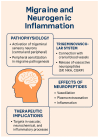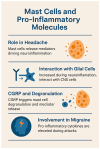Metabolic Dysfunction and Dietary Interventions in Migraine Management: The Role of Insulin Resistance and Neuroinflammation-A Narrative and Scoping Review
- PMID: 40426647
- PMCID: PMC12109628
- DOI: 10.3390/brainsci15050474
Metabolic Dysfunction and Dietary Interventions in Migraine Management: The Role of Insulin Resistance and Neuroinflammation-A Narrative and Scoping Review
Abstract
Introduction: Migraine is a prevalent neurological disorder characterized by recurrent headaches with autonomic and neurological symptoms, significantly impacting quality of life globally. Its pathogenesis involves genetic, neurological, inflammatory, and metabolic factors, with insulin resistance and metabolic dysfunction increasingly recognized as important contributors. Historically, it has been known that certain foods can trigger migraine attacks, which led for many years to the recommendation of elimination diets-now understood to primarily target histamine-rich foods. Over the past two decades, attention has shifted toward underlying metabolic disturbances, leading to the development of dietary approaches specifically aimed at addressing these dysfunctions.
Methods: A scoping literature review was conducted using PubMed and Embase to evaluate the relationships among migraine, insulin-related mechanisms, neurogenic inflammation, and dietary interventions. Initial searches focused on "MIGRAINE AND (neurogenic inflammation)" (2019-15 April 2025), followed by expanded searches from 1950 onward using terms such as "MIGRAINE AND (insulin, insulin resistance, hyperinsulinism)", and "MIGRAINE AND (diet, dietary, nutrition, nutritional)". A specific search also targeted "(INSULIN OR insulin resistance OR hyperinsulinism) AND (neurogenic inflammation)". Abstracts were screened, full texts were retrieved, and duplicates or irrelevant publications were excluded. No filters were applied by article type or language. Systematic reviews and meta-analyses were prioritized when available.
Results: Migraine pathogenesis involves trigeminovascular system activation, neurogenic inflammation mediated by CGRP and PACAP, immune dysregulation, mast cell activation, and cortical spreading depression (CSD). Emerging evidence highlights significant associations between migraine, insulin resistance, and hyperinsulinism. Hyperinsulinism contributes to migraine through TRPV1 sensitization, increased CGRP release, oxidative stress, mitochondrial dysfunction, and systemic inflammation. Metabolic dysfunction, including obesity and insulin resistance, exacerbates migraine severity and frequency. Dietary interventions, particularly anti-inflammatory, Mediterranean, and ketogenic diets, show promise in reducing migraine frequency and severity through mechanisms involving reduced inflammation, oxidative stress, improved mitochondrial function, and glucose metabolism stabilization.
Conclusions: The interplay between insulin resistance, metabolic dysfunction, and neuroinflammation is crucial in migraine pathophysiology. Targeted dietary interventions, including ketogenic and Mediterranean diets, demonstrate significant potential in managing migraines, emphasizing the need for personalized nutritional strategies to optimize therapeutic outcomes.
Keywords: diet; dietary; inflammation; insulin; migraine; neurogenic inflammation.
Conflict of interest statement
The author declares no conflicts of interest.
Figures









References
Publication types
LinkOut - more resources
Full Text Sources
Research Materials
Miscellaneous

